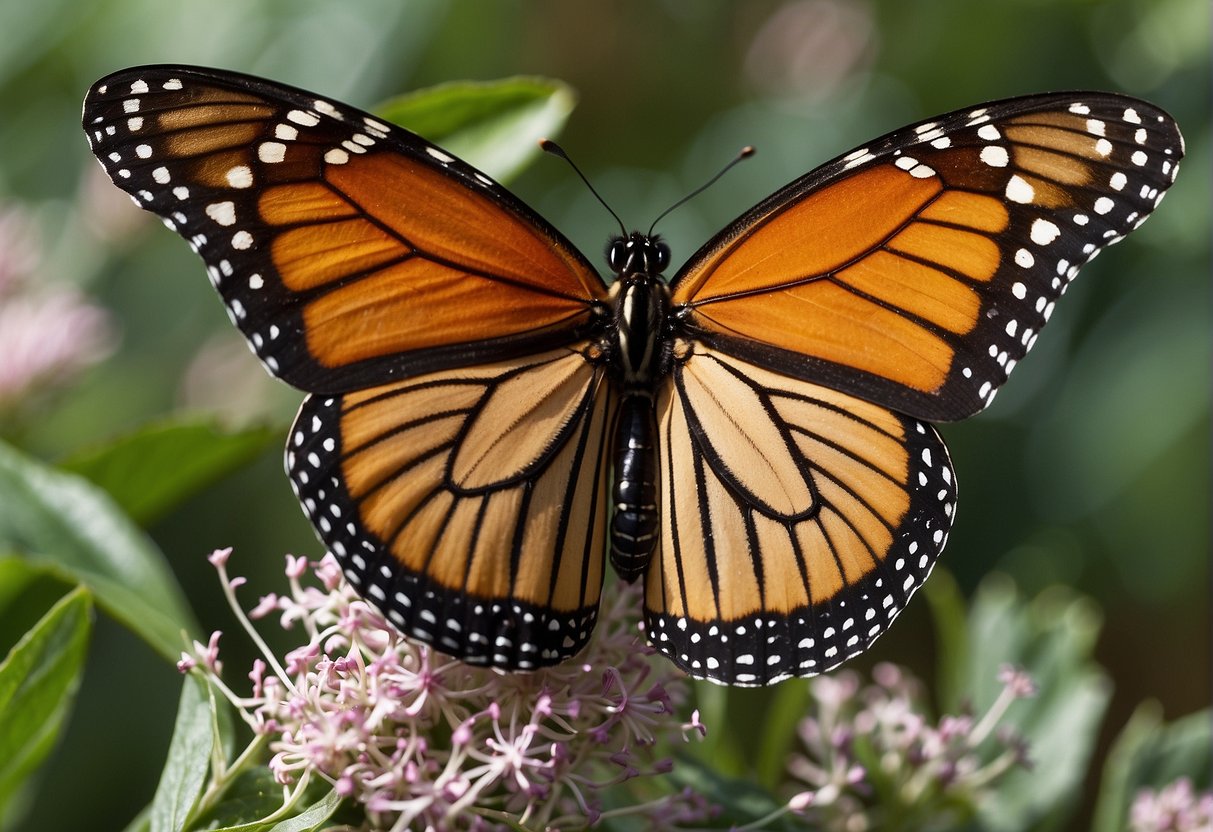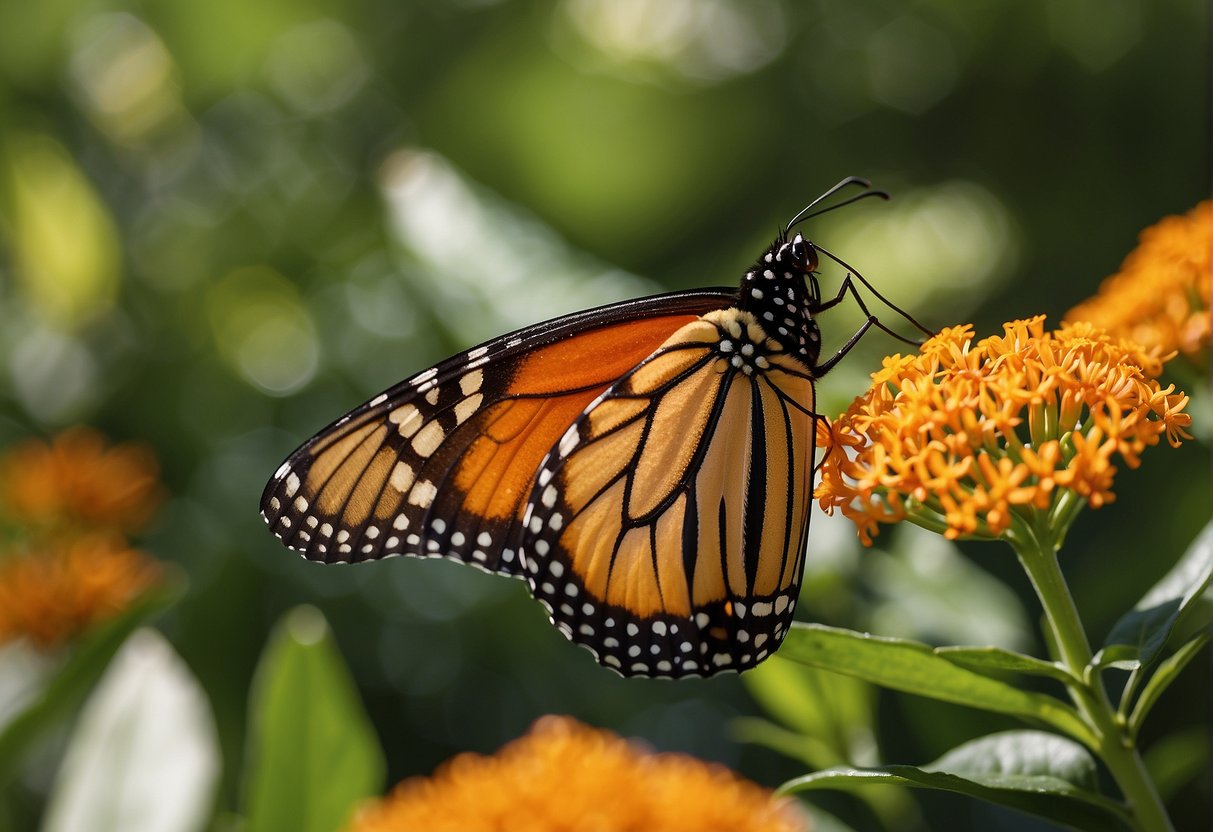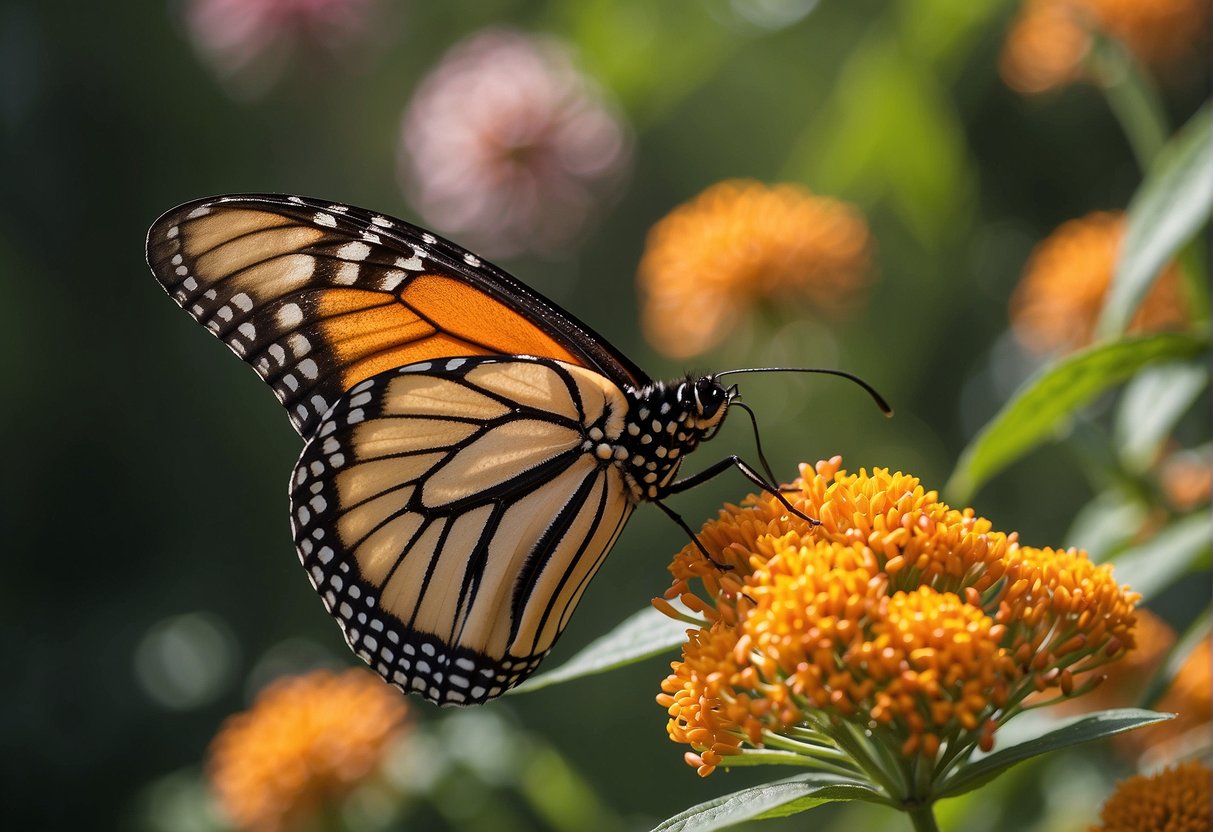How Monarch Butterflies Avoid Poisoning from Cardenolide in Milkweed
Have you ever been curious about the ability of a monarch butterfly to feed on milkweed, despite it harboring a poisonous substance known as cardenolide, without succumbing to toxicity? This captivating dynamic between the monarch butterfly and the milkweed plant has piqued the interest of researchers for many years. In this piece, we will delve into the adaptations that empower monarch butterflies to withstand and neutralize the poisonous impacts of cardenolides.

Cardenolides are a group of chemicals found in milkweed plants that are toxic to many animals, including humans. However, monarch butterflies have evolved to tolerate and even use these toxins to their advantage. The ability of monarch butterflies to consume milkweed without getting poisoned has been a subject of intense research, and scientists have uncovered several fascinating adaptations that allow them to do so. In the following paragraphs, we will delve into the different mechanisms that monarch butterflies use to resist the toxic effects of cardenolides.
Key Takeaways
- Monarch butterflies have evolved to tolerate the toxic effects of cardenolides found in milkweed plants.
- The adaptation of monarch butterflies to cardenolides involves several mechanisms, including sequestration, metabolism, and excretion.
- Understanding how monarch butterflies resist cardenolides has important implications for conservation and the study of chemical ecology.
Monarch Butterfly and Milkweed Interaction
The relationship between the monarch butterfly and milkweed plant is unique and complex. Monarch butterflies rely heavily on milkweed plants for their survival, yet these plants contain a toxic substance called cardenolide that can be lethal to many other insects.
Host Plant Selection
Monarch butterflies are highly selective when it comes to choosing their host plants for laying eggs. They are able to detect the presence of cardenolide in milkweed leaves and will only lay their eggs on plants that contain the appropriate levels of this toxin. This selective behavior is believed to be learned from the mother butterfly, who passes on her knowledge of suitable host plants to her offspring.
Life Cycle Reliance on Milkweed
The life cycle of the monarch butterfly is closely tied to the milkweed plant. After hatching from their eggs, monarch caterpillars feed exclusively on milkweed leaves. The cardenolide toxin in the milkweed plant actually serves as a defense mechanism for the monarch butterfly, making them unpalatable to predators.
As the caterpillars grow and develop, they accumulate the cardenolide toxin in their bodies, making them toxic to predators as well. This toxin is then retained by the adult butterfly, providing them with protection throughout their entire lifespan.
In conclusion, the monarch butterfly and milkweed plant have a fascinating and mutually beneficial relationship. The monarch butterfly has evolved to tolerate the toxic effects of cardenolide, while the milkweed plant has evolved to produce this toxin as a defense mechanism. This coevolution has allowed both species to thrive and persist in their respective environments.
Cardenolides: The Toxic Defense

As you may know, milkweed plants contain a toxic chemical called cardenolide. This toxin is meant to protect the plant from herbivores, but how do monarch butterflies manage to feed on milkweed without being poisoned?
Chemical Properties of Cardenolides
Cardenolides belong to a class of compounds called cardiac glycosides, which are known for their ability to disrupt the sodium pump in animal cells. This disruption can lead to a range of physiological effects, including cardiac arrest.
Milkweed produces several different types of cardenolides, each with slightly different chemical properties. Some are more toxic than others, and some are more readily absorbed by animal cells.
Milkweed’s Toxic Mechanism
When a monarch butterfly feeds on milkweed, it ingests small amounts of cardenolides along with the plant material. These cardenolides are absorbed into the butterfly’s body, but they do not disrupt the sodium pump in the same way that they do in other animals.
Scientists believe that monarch butterflies have evolved a unique mechanism for dealing with cardenolides. One theory is that they have developed a way to sequester the toxin in their bodies, preventing it from reaching critical organs like the heart.
Another theory is that monarch butterflies have adapted their sodium pump to be less sensitive to cardenolides. This would allow them to continue pumping sodium ions across their cell membranes even in the presence of the toxin.
Overall, the exact mechanism by which monarch butterflies avoid cardenolide poisoning is still not fully understood. However, it is clear that they have evolved a remarkable ability to tolerate this potent toxin, allowing them to feed on milkweed without harm.
Monarch’s Adaptation to Toxins

The monarch butterfly is well known for its ability to feed on milkweed plants, which contain toxic cardenolides that can be lethal to many other insects. However, the monarch has evolved several adaptations that allow it to avoid the toxic effects of these compounds.
Evolutionary Adaptations
Over time, monarchs have developed the ability to tolerate and even sequester cardenolides from the milkweed plant into their own bodies. This adaptation is believed to have arisen due to a process known as coevolution, where the monarch and the milkweed plant have evolved together over millions of years.
As a result of this coevolution, the monarch has developed specialized enzymes in its gut that are able to break down and detoxify the cardenolides. In addition, the monarch’s immune system has evolved to recognize and neutralize any harmful effects of the toxins.
Genetic Mutations and Resistance
Another adaptation that has helped the monarch to survive in the presence of cardenolides is the occurrence of genetic mutations that confer resistance to the toxins. Researchers have identified several genes that are involved in this process, including those that are responsible for the production of detoxifying enzymes and those that are involved in the uptake and transport of cardenolides.
These genetic mutations are believed to have arisen through a process known as natural selection, where monarchs with advantageous traits are more likely to survive and pass on their genes to future generations.
In conclusion, the monarch butterfly has evolved several adaptations that allow it to feed on milkweed plants without being poisoned by the toxic cardenolides. These adaptations include the ability to detoxify the toxins through specialized enzymes and an immune system, as well as genetic mutations that confer resistance to the toxins.
Implications of Monarch’s Cardenolide Resistance
Predator-Prey Dynamics
Monarch butterflies have evolved to be resistant to the toxic cardenolides found in milkweed, which is their primary food source. This adaptation has allowed them to survive and thrive in the presence of predators that are unable to tolerate the toxins.
The ability of monarchs to sequester cardenolides from milkweed and use them as a defense mechanism has created an evolutionary arms race between the butterfly and its predators. Predators that are able to tolerate the toxins are more likely to survive and reproduce, while those that cannot are less likely to pass on their genes.
This dynamic has led to the emergence of specialist predators that are able to feed on monarchs without being affected by the toxins. These predators have adapted to the presence of cardenolides in their diet and are able to break down the toxins or store them in specialized organs.
Ecological Impact
The presence of toxic milkweed and the evolution of cardenolide resistance in monarchs has had a ripple effect throughout the ecosystem. The ability of monarchs to survive in the presence of predators has allowed them to maintain their population size and continue to play a vital role in the ecosystem.
Monarchs are important pollinators and are also a food source for a variety of animals, including birds, spiders, and other insects. The loss of monarchs due to the absence of milkweed or the inability to tolerate the toxins could have far-reaching ecological consequences.
The evolution of cardenolide resistance in monarchs has also had implications for the management of invasive species. Milkweed is often considered a weed and is routinely removed from agricultural fields and other areas. However, the presence of milkweed is essential for the survival of monarchs, and efforts are being made to promote the planting of milkweed in areas where it has been removed.
Overall, the cardenolide resistance of monarchs has allowed them to survive and thrive in the face of adversity. The implications of this adaptation are far-reaching and highlight the complex interplay between species in the natural world.
Visual Signals and Defense
Monarch butterflies are well-known for their bright orange and black wings. These colors serve as a warning to predators that they are toxic and unpalatable. However, the bright colors alone are not enough to protect them. In addition to warning coloration, monarchs have developed several other strategies to defend themselves against predators.
Warning Coloration
The bright orange and black colors of a monarch butterfly serve as a warning to predators that they are toxic and unpalatable. This is because monarchs feed on milkweed, which contains a toxin called cardenolide. The toxin is stored in the monarch’s body, making them poisonous to predators. The bright colors of the monarch’s wings are a visual signal to predators that they should stay away.
Mimicry and Survival
Some other butterflies and moths have evolved to mimic the bright warning colors of the monarch butterfly. This is called Batesian mimicry, and it allows the mimicking species to avoid predation by fooling predators into thinking they are toxic like the monarch. The viceroy butterfly is a well-known example of a species that has evolved to mimic the warning coloration of the monarch butterfly.
Monarch butterflies also have a survival advantage because they can detect the levels of cardenolide in the milkweed they feed on. This allows them to avoid plants with high levels of the toxin, which could be harmful to them. They also have the ability to detoxify the cardenolide in their bodies, making them less toxic over time.
In conclusion, the bright colors of the monarch butterfly serve as a warning to predators that they are toxic and unpalatable due to the toxin cardenolide found in milkweed. Mimicry by other species and the monarch’s ability to detect and detoxify the toxin further enhance their survival.
Research and Scientific Studies
Genetic Research on Monarch Resistance
Scientists have been studying the genetic makeup of monarch butterflies to understand how they have evolved to resist the toxic effects of milkweed cardenolides. Recent research has revealed that the monarch genome contains several genes that are involved in the detoxification of cardenolides. These genes are believed to have evolved in response to the coevolutionary arms race between monarchs and milkweed plants, which has been ongoing for millions of years.
One study published in the Annual Review of Ecology, Evolution, and Systematics found that monarch butterflies have evolved a unique set of gene duplications and mutations that allow them to detoxify cardenolides more efficiently than other insects. This genetic adaptation is believed to have played a crucial role in the monarch’s ability to feed exclusively on milkweed plants, which are toxic to most other animals.
Future Directions in Monarch Conservation
Given the recent decline in monarch populations, there is a growing need for conservation efforts to protect this iconic species. One potential avenue for conservation is the use of gene-editing technologies such as CRISPR-Cas9 to enhance the monarch’s resistance to cardenolides. While this approach is still in its early stages, it has the potential to be a powerful tool for conservation biologists.
However, it is important to note that any genetic modifications must be carefully considered and thoroughly tested before being implemented in the wild. There are still many unknowns when it comes to the long-term effects of genetic modifications on ecosystems and biodiversity. As such, any conservation efforts must be approached with caution and a deep understanding of the potential risks and benefits.
In addition to genetic research and gene-editing, there are also many other conservation strategies that can be employed to protect monarch butterflies. These include habitat restoration and protection, public education and outreach, and the development of sustainable agricultural practices that minimize the use of pesticides and other harmful chemicals. By taking a multifaceted approach to conservation, we can help ensure that monarch butterflies continue to thrive for generations to come.
Additional Considerations
Environmental Factors Affecting Monarch and Milkweed
In addition to the monarch’s ability to detoxify cardenolides, there are several environmental factors that affect both monarch butterflies and milkweed plants. Milkweed species are native to North America and are commonly found in fields, roadsides, and other open areas. The common milkweed is the most well-known species and is the primary host plant for monarch butterflies.
Monarch butterflies are known for their long-distance migration from North America to Mexico. During their journey, they rely on milkweed plants as a food source and as a place to lay their eggs. However, habitat loss due to human activities such as agriculture, urbanization, and the use of pesticides has led to a decline in milkweed populations. This loss of habitat has had a significant impact on monarch populations, and efforts are underway to restore and protect milkweed habitats.
Human Impact on Monarch Migration
Human activities have also had a significant impact on monarch migration. The construction of roads and buildings has disrupted monarch migration routes, making it more difficult for them to reach their wintering grounds in Mexico. Additionally, the use of pesticides and herbicides has led to a decline in milkweed populations, which is a crucial food source for monarchs.
Efforts are underway to mitigate these impacts and protect monarch populations. Organizations such as the Monarch Joint Venture are working to restore and protect milkweed habitats and educate the public about the importance of monarch conservation. By working together, we can help ensure the survival of these beautiful and important insects.
Overall, the monarch butterfly’s ability to detoxify cardenolides is just one of many factors that contribute to their survival. By understanding the complex relationship between monarchs and milkweed plants, we can work to protect and conserve these important species for future generations.
Frequently Asked Questions
How do monarch butterflies tolerate the toxins found in milkweed?
Monarch butterflies have evolved the ability to tolerate the toxins found in milkweed by sequestering and storing them in their bodies. They have specialized enzymes that can break down and detoxify the toxins, allowing them to consume milkweed without getting poisoned.
In what way do cardenolides affect the toxicity of monarch butterflies?
Cardenolides are the toxins found in milkweed that can be harmful to most animals. However, monarch butterflies have evolved to use these toxins to their advantage. They store the toxins in their bodies and use them as a defense mechanism against predators.
What adaptations allow monarch butterflies to consume milkweed safely?
Monarch butterflies have several adaptations that allow them to consume milkweed safely. They have a specialized gut that can handle the toxins found in milkweed, and they can selectively choose the least toxic parts of the plant to eat. Additionally, they have evolved to have a high tolerance for the toxins, allowing them to consume much more than other animals.
How is the monarch butterfly’s warning coloration linked to its diet of milkweed?
The bright orange and black coloration of monarch butterflies is a warning to predators that they are toxic. This warning coloration is linked to their diet of milkweed because they sequester and store the toxins found in the plant, making them unpalatable and toxic to predators.
Can monarch butterflies derive toxicity from other sources besides milkweed?
Monarch butterflies can derive toxicity from other sources besides milkweed, but the levels of toxicity are much lower. They can consume other plants that contain similar toxins, but milkweed is their primary source of toxicity.
What mechanisms do monarch butterflies have to store and utilize plant toxins for defense?
Monarch butterflies have specialized enzymes that allow them to break down and detoxify the toxins found in milkweed. They store the toxins in their bodies and use them as a defense mechanism against predators. Additionally, they have evolved warning coloration to signal to predators that they are toxic.


